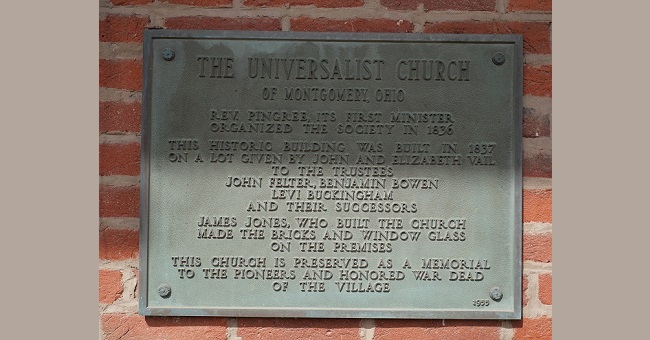by Mike Roberts, Church Historian
As we all are aware, the roots of our Universalist religion were originally planted in the New England and Mid-Atlantic states. While much of our nativity centered in Philadelphia, New York and especially Boston, its spread found new followers in rural New England, and it was from here that many of the church’s 19th century leaders emerged. As Universalism spread westward, it could be found in large cities like Cincinnati but, like New England, it also took a very strong hold in rural Midwest. Between 1830 and 1860 from its base in Cincinnati, Universalist churches appeared in Higginsport, New Richmond, Felicity, Bethel, Amelia, Mt. Carmel, Batavia, Newtown, Indian Hill, Milford, Delhi, Montgomery, Goshen, Blanchester, Sharonville, Mason, Princeton and Hamilton. While these towns and cities are now well-populated appendages of the Cincinnati metropolitan area, in the first half of the 19th century most were very small agrarian communities. Few of these congregations could afford let alone find a settled minister. It was common practice for these churches to be served by circuit riders or to be served by shared ministers who might pastor three or even four churches.
Of those churches in small communities, Montgomery is one of the most remembered. The church was founded by locals who left the Hopewell Presbyterian Church. Land was purchased for $75 in 1835 and carpenters were hired to build the church. Bricks were made by church members in a kiln located on the church property. Some of the bricks were imprinted with house keys and can still be seen on the building. Silver coins were added to the metal when the bell was cast giving it a charming and unusual ring. The structure was completed in 1837. Enoch Pingree, a prominent figure in Universalist circles was hired as the first minister. By the mid-1840’s the church contained 44 full members many of whom were among the most prominent citizens of Montgomery. Other ministers who served during the early years of the church included: John Gurley, also a minister to our church; Gerhardus Demerest, again a minister to our church and later national secretary to the Universalist Church; Marion Crosley, brother of Powel Crosley Sr. and uncle of Powel Crosley Jr. (a longtime member of our church and owner of WLW and the Cincinnati Reds); and, John Cantwell, editor of the Western edition of the Universalist Leader. The Universalist state convention was hosted by Montgomery in 1843.
The church thrived through most of the 19th century. Because of its location in downtown Montgomery, it was a center of town activities. The bell was used to call firefighters when a blaze occurred in town. The bell was also used to muster the militia during the Civil War especially on the day when Morgan and his raiders rode through the downtown. In 1880, Montgomery was struck with a powerful tornado. The church walls were separated in two. However, master carpenters made repairs, saved the structure and left no evidence of the crack in the walls.
Membership waned in the early 1900s. In 1926, Montgomery shared newly ordained minister Robert Cummins with several other Southwestern Ohio churches. He soon took the position of minister to our church and delivered the final sermon at the Montgomery church in 1926. Upon his leaving, the Montgomery Universalist Church permanently closed its doors. Cummins went on to become the fifth Superintendent of the Universalist Church of America and was a forerunner in paving the way for our unification with the Unitarian Church.
For a number of years, the Montgomery church sat unused and deteriorating. However, a group of civic-minded citizens of Montgomery decided to save the structure and restore it as an important relic of its historic downtown. A Montgomery gardening club first added decorative plants, pulled weeds, and beautified the landscape of the property. That effort was assisted by Miss Georgia Green, a member of our church who was active in many Cincinnati charitable organizations. Miss Green also received assistance through financial grants from the national Universalist Church. There was much interest in preserving the structure which then and now is the oldest surviving Universalist Church building in the State of Ohio.
Assistance was also provided by Mrs. Bertha Crosley Ball. Mrs. Ball was the daughter of former Montgomery minister, Marion Crosley. She was also the wife of Edmund Burke Ball, one of the founding brothers of the Ball Jar Company. Mrs. Ball had been involved in numerous restorations including the former homes of Robert E. Lee and a sister of George Washington and several buildings in Harrodsburg, Kentucky with which Abraham Lincoln had association. She was also awarded the French Legion of Honor for the restoration of a museum in France.
Even with this support restoration foundered and in 1962 the church was scheduled for demolition for the building of a gas station. The Behrens family stepped forward and bought the church with the hope of it being preserved for the city. New restoration efforts were finished and the heirs of Tom and Edith Behrens deeded the property to the City of Montgomery. In 1970, the church was placed on the National Register of Historic Places.
The reward for those who gave so much to save the church is the preservation of this beautiful centerpiece of the Montgomery historic district. Pamphlets which allow for a self-guided walk through the district are available in a box at the front of the church.


Top image: Universalist Church building in Montgomery, Ohio.
All photographs are by Mike Roberts.

